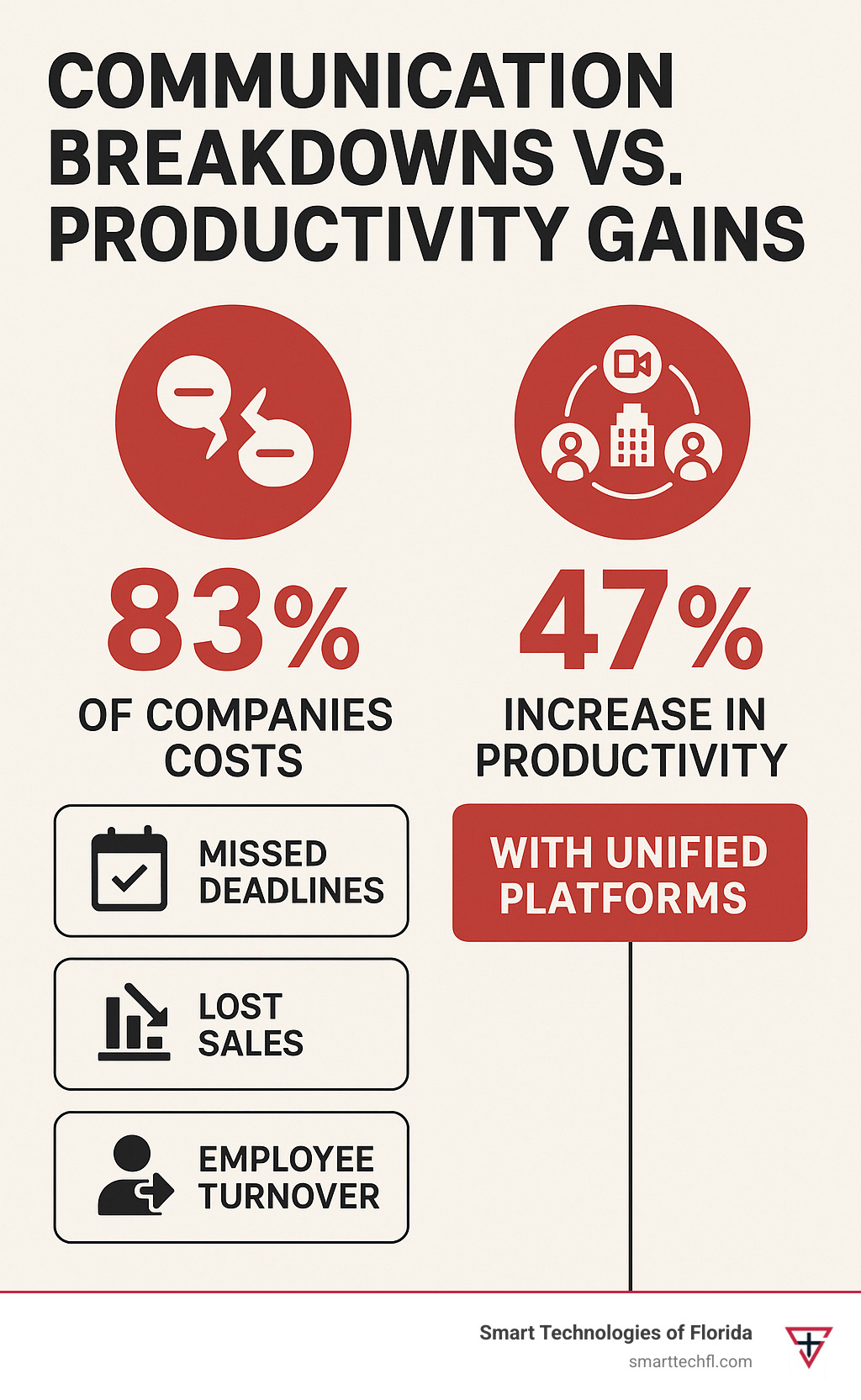Choosing the Right Communication Platform for Your Business
A communication platform is software that enables messaging, collaboration, and information sharing within organizations through multiple channels like chat, video, voice, and file sharing. These platforms centralize team communication, streamline workflows, and connect employees regardless of location.
Key Communication Platform Types:
- Internal platforms – Team messaging, video conferencing, project collaboration
- External platforms – Customer support, live chat, business phone systems
- Unified solutions – Integrated voice, video, messaging, and collaboration tools
- Specialized platforms – Industry-specific or feature-focused solutions
The numbers tell a stark story. Research shows that 83% of companies have experienced missed deadlines, lost sales, and even employee turnover due to communication breakdowns. That’s not just an operational hiccup – it’s a direct hit to your bottom line.
For mid-sized retail businesses, this challenge has become even more critical. The shift to remote and hybrid work models means your team isn’t gathered around the same conference table anymore. Your sales staff might be working from home, your inventory managers could be on-site, and your customer service team may be split between locations.
Poor communication creates expensive problems:
- Projects fall behind schedule
- Customer complaints go unresolved
- Team members duplicate work
- Important decisions get delayed
- Employee frustration leads to turnover
Meanwhile, businesses using centralized communication platforms report 47% increases in productivity and significant improvements in collaboration efficiency. The difference? They’ve moved beyond scattered emails, missed phone calls, and information silos.
Your business deserves better than communication chaos. The right platform doesn’t just connect your team – it transforms how work gets done.

Why a Centralized Communication Platform is Crucial for Modern Business
When your team is scattered across different locations—some working from home, others in the office, and maybe a few on the road—keeping everyone connected becomes your biggest challenge. That’s where a well-designed communication platform becomes absolutely essential for your business success.
Think about it: when communication breaks down, everything else falls apart too. Projects get delayed, customers get frustrated, and your best employees start looking elsewhere. But when you have the right system in place, something magical happens. Information flows smoothly, decisions get made faster, and your team actually enjoys working together.
A centralized communication platform does more than just connect people—it transforms how your business operates. It breaks down those frustrating information silos where important details get trapped in someone’s email inbox. Instead, everyone has access to what they need, when they need it.
The results speak for themselves. Businesses that accept unified communication see real improvements: higher productivity, better collaboration efficiency, and stronger employee engagement. Your team starts meeting deadlines consistently, and that constant stress of miscommunication fades away.
For a deeper understanding of how this change works, our guide on Unified Communications In Business Success shows you the complete picture. You’ll also find valuable insights in our article about Centralized Communication For Businesses.
Enhancing Productivity and Collaboration
Picture this: your project manager in Miami needs to coordinate with your inventory team in Tampa while your customer service rep in Orlando handles a client issue. With the right communication platform, this happens seamlessly—no phone tag, no delayed emails, no confusion.
Modern platforms excel at supporting both real-time collaboration for urgent matters and asynchronous communication for everything else. Your team can jump into an instant discussion when needed, but they’re not chained to their desks waiting for responses to every little question.
The real productivity boost comes from smart automation and streamlined workflows. Instead of drowning in administrative tasks, your team focuses on what actually matters. Task automation handles the routine stuff, file sharing happens instantly, and everyone stays aligned without endless status meetings.

The best part? Fewer meetings and faster decision-making become your new normal. When information is centralized and accessible, your team spends less time hunting for details and more time getting things done. Some businesses report saving nearly two hours per week per employee just from better organization and AI-powered summaries.
Our Business Communication Tools Guide dives deeper into maximizing these productivity gains for your specific business needs.
Boosting Employee Engagement and Culture
Here’s something many business owners miss: the right communication platform doesn’t just improve workflows—it strengthens your company culture. When people feel connected and heard, they’re naturally more engaged and likely to stick around.
Fostering transparency becomes effortless when leadership can share updates, celebrate wins, and address concerns openly. Virtual townhalls and company-wide announcements help everyone feel like they’re part of something bigger, even when they’re working from their kitchen table.
The magic happens in the everyday interactions too. Employee feedback flows more freely when there are easy channels for questions and suggestions. Recognition and praise become part of your daily rhythm instead of formal quarterly reviews. Team members start building community around shared interests and projects.
Supporting work-life balance is another unexpected benefit. When communication is efficient and organized, people aren’t checking messages at all hours trying to catch up. They can disconnect knowing they won’t miss anything critical.
This approach to leadership communication and team connection significantly reduces employee turnover while boosting team morale. When your people feel valued and connected, they bring their best to work every day.
Learn more about creating this kind of positive communication environment in our article on Enterprise Communications Tools: Key Benefits.
Key Types of Business Communication Platforms
When you’re looking for the right communication platform, it helps to understand that most tools fall into three main categories. Think of it like choosing the right vehicle for different journeys – you wouldn’t use a delivery truck for a family road trip, and you wouldn’t use a sports car to haul equipment.
The landscape has dramatically shifted toward cloud-based solutions, making these platforms more accessible and flexible than ever. Your team can now connect from anywhere, whether they’re in the office, at home, or traveling between client sites. This flexibility has become essential, not just convenient. For a deeper look at how cloud solutions can transform your operations, check out our Cloud Communication Platforms Guide.

Internal Team Collaboration Platforms
These are the digital workspaces where your team lives and breathes together every day. Internal collaboration platforms serve as the backbone of modern teamwork, connecting employees regardless of whether they’re sitting next to each other or working from different time zones.
Instant messaging and team channels create those essential quick conversations that used to happen by someone’s desk. Instead of walking across the office to ask a quick question, your team can get immediate answers while keeping organized records of project discussions. It’s like having dedicated project rooms that never close.
Video conferencing brings back the human element that text messages can’t provide. Those facial expressions, hand gestures, and spontaneous “aha!” moments during brainstorming sessions are irreplaceable. Whether it’s daily stand-ups, training sessions, or important client presentations, video keeps your team connected on a personal level.
Intranets and knowledge sharing features turn your platform into a living library. Instead of hunting through old emails for that policy document or wondering who to ask about vacation procedures, employees can find what they need instantly. This self-service approach saves everyone time and reduces frustration.
Picture this: Your marketing team is launching a new campaign. They create a dedicated channel where designers share creative assets, copywriters collaborate on messaging, and the project manager tracks deadlines. Everyone stays aligned without drowning in email chains or missing crucial updates.
Or consider company-wide announcements. Instead of sending mass emails that might get buried in busy inboxes, important news reaches every employee directly and immediately. No one misses the holiday party details or the new safety protocols.
These tools don’t just facilitate communication – they build the foundation for a cohesive, efficient workplace culture. Learn more about optimizing your internal systems in our guide to Business Communications Systems.
External and Customer-Facing Platforms
While internal tools keep your team humming, external communication platforms are your bridge to the outside world. These are the tools that make your business accessible, responsive, and professional in the eyes of your customers and partners.
Modern business phone systems have evolved far beyond simple voice calls. Today’s cloud-based systems offer features like intelligent call routing, professional auto-attendants, and voicemail-to-email functionality. Your customers always reach the right person, even when your team is spread across multiple locations.
Live chat and helpdesk software meet customers where they are – right on your website when they need help most. These tools don’t just enable real-time conversations; they create a complete support ecosystem. Your agents can see customer history, track ongoing issues, and resolve problems faster than ever before.
Email and SMS marketing platforms extend your reach directly into your customers’ daily lives. The best platforms let you meet clients on their preferred channels, whether that’s traditional email, text messages, or even popular messaging apps. Some platforms even record conversations for compliance purposes, which is crucial for regulated industries.
Imagine a customer experiencing an issue with your product. They start a live chat on your website, and your support agent immediately sees their purchase history, previous interactions, and account details. The problem gets solved in minutes, not days.
Or consider your sales team launching a time-sensitive promotion. They can send personalized SMS messages to opted-in customers, achieving engagement rates that traditional email simply can’t match. The immediacy of text messaging can turn a slow sales week into a successful one.
These external-facing tools are your competitive advantage in building lasting customer relationships. For businesses looking to upgrade their phone systems, our Best Phone Systems For Small Business guide offers practical insights.
Unified Communications Solutions
Here’s where the magic really happens. Unified communications solutions represent the ultimate evolution of business communication technology. Instead of juggling separate apps for calls, video meetings, and team chat, these integrated platforms bring everything together under one digital roof.
Think about your typical workday. You start with checking team messages, hop on a video call, then need to make a quick phone call to a client. With unified communications, all of these transitions happen seamlessly within the same application. No more switching between apps, remembering different passwords, or losing conversation context.

The benefits go far beyond convenience. Reduced complexity means your IT team manages one platform instead of multiple systems, and your employees only need to learn one interface. Improved collaboration flows naturally when all communication channels work together harmoniously.
Scalability becomes effortless. Whether you’re adding five new team members or expanding to fifty, the system grows with you without requiring major infrastructure changes. This flexibility is particularly valuable for growing businesses that can’t predict exactly what their communication needs will look like next year.
Cost efficiency often surprises business owners. Consolidating multiple communication services typically reduces overall expenses while improving functionality. You’re paying for one comprehensive solution instead of several partial ones.
The result is a truly connected workplace where communication barriers disappear. Your team can focus on what they do best instead of wrestling with technology. Find more about these powerful solutions in our article on Cloud-Based Unified Communications Benefits.
Must-Have Features to Evaluate in a Communication Platform
When you’re shopping for a communication platform, it’s like choosing the perfect toolkit for your business. You want something that works reliably, grows with you, and makes everyone’s job easier – not harder.
Think of it this way: your platform will become the digital heartbeat of your organization. Every conversation, every file share, every quick “can you check this?” moment will flow through it. That’s why getting the feature set right matters so much.
The essentials we always recommend focusing on include security to protect your conversations, scalability that grows with your team, integrations that connect your existing tools, mobile access for work on the go, usability that won’t frustrate your team, analytics to understand what’s working, reliability you can count on, and solid customer support when things go sideways.
Security and Compliance
Let’s be honest – data breaches make headlines for all the wrong reasons. Your communication platform needs to be Fort Knox for your business conversations.
End-to-end encryption should be non-negotiable. This means your messages stay private between sender and recipient, even if someone intercepts them along the way. Some platforms build this privacy protection right into their DNA, making it the default rather than an optional add-on.
Multi-factor authentication adds that extra security layer we all need. It’s one more step, but it’s the difference between leaving your front door open uped and having a proper security system.
Here’s something many businesses overlook: data privacy policies. Does your platform sell your information to advertisers? Do they track everything you do? The best platforms operate on models that put user privacy first, with no ads and no data harvesting.
If you’re in healthcare, finance, or other regulated industries, compliance with HIPAA, GDPR, and similar regulations isn’t optional – it’s the law. Make sure your platform can handle these requirements without breaking a sweat.
Access controls let you decide who sees what, while content moderation tools help maintain professional standards. It’s like having a good bouncer at your digital door.
Your communications deserve the same protection as your physical assets. For deeper insights on protecting your digital conversations, explore our guide on Secure Email Software.
Integrations and Scalability
A communication platform that doesn’t play nicely with your other business tools is like having a phone that only calls certain numbers – technically functional, but practically frustrating.
API access and robust app ecosystems are game-changers. The best platforms connect with thousands of other business applications, turning your communication hub into mission control for your entire operation. Instead of jumping between five different apps to get work done, everything flows together naturally.
CRM integration means your sales team can see customer history, log calls, and update records without leaving their chat window. It’s the kind of seamless experience that saves hours every week and prevents things from falling through the cracks.
Project management connections bring tasks, deadlines, and updates right into your conversations. When someone mentions the Johnson project, relevant files and timelines appear automatically. No more “which folder was that in?” moments.
Future growth and flexible pricing matter more than you might think. Your team today might be 15 people, but what about next year? Or in five years? The right platform scales effortlessly, with pricing that grows with you instead of forcing expensive upgrades you’re not ready for.
Your communication strategy should evolve with your business, not hold it back. Learn more about flexible communication solutions in our article on CPaaS Solutions For Business Communication.
The Future is Now: AI’s Role in Changing Business Communication
The world of business communication is experiencing a shift, and artificial intelligence is at the heart of it. What once seemed like science fiction is now reality, with AI capabilities becoming standard features in modern communication platforms. This isn’t just about having fancy new tools – it’s about fundamentally changing how we work and communicate.
We’re witnessing AI ready to fundamentally change how we work, leading to a rethinking of Work Value in an AI World. The impact on daily business operations is already remarkable.
Think about how much time you spend catching up on conversations you missed while you were in meetings or focused on other tasks. AI assistants are now solving this challenge by providing automated summaries of channels, threads, and daily message digests. Some users are saving nearly 100 minutes weekly – that’s almost two hours back in their workweek just from AI-powered summaries.
Intelligent search capabilities have transformed how we find information. Instead of scrolling through weeks of conversations to find that important decision or document, AI can search your entire company’s communication history and surface exactly what you need in seconds. It’s like having a personal assistant who remembers everything and can find it instantly.
For businesses working with global teams or international clients, real-time translation is breaking down language barriers like never before. AI can translate messages as they’re typed and even provide live translation during video calls, making truly global collaboration seamless and natural.
Workflow automation through AI agents is perhaps the most exciting development. These smart assistants can handle routine tasks, connect different applications, and even suggest replies based on context. In customer service scenarios, this technology is boosting resolution rates while reducing response times, ensuring customers get consistent, efficient support.
More sophisticated platforms are beginning to incorporate sentiment analysis, which helps managers understand team morale and customer satisfaction levels before small issues become big problems.

What’s beautiful about this AI integration is that it’s not replacing human connection – it’s enhancing it. We’re not losing the personal touch that makes business relationships meaningful. Instead, we’re getting back time and mental energy to focus on what humans do best: creative problem-solving, relationship building, and strategic thinking.
The result is an AI workforce that supports your human team, scaling to meet demand and continuously learning to serve your business better. It’s like having the most efficient assistant imaginable, one that never sleeps and gets smarter every day.
How to Choose the Right Platform for Your Needs
Choosing the perfect communication platform for your business is like finding the right pair of running shoes – it needs to fit your unique needs, support your goals, and carry you through the long haul. There’s no magic formula that works for everyone, which is why we take a personalized approach with every client.
The secret lies in understanding four key areas: your specific purpose, your team dynamics, the types of conversations you have daily, and the resources you can realistically commit. When these elements align with the right platform, magic happens. For comprehensive insights into solutions that actually deliver results, check out our guide on Business Communication Solutions That Work.
Think of this process as building a foundation. Rush through it, and you’ll end up with a shaky structure that frustrates your team and wastes your investment. Take the time to get it right, and you’ll have a communication platform that transforms how your business operates.
Step 1: Assess Your Core Business Needs
Before you get impressd by fancy features and sleek interfaces, take a step back and honestly evaluate what your business actually needs. This isn’t about what looks cool – it’s about what will genuinely solve your problems.
Start by asking yourself whether your biggest challenge is internal collaboration or external customer communication. Maybe your team struggles to stay aligned on projects, or perhaps customers can’t reach the right person quickly enough. Most businesses face both challenges, but identifying your primary pain point helps you prioritize features that matter most.
Next, dig into your specific pain points. Are deadlines slipping through the cracks? Is important information getting buried in email chains? Do remote team members feel disconnected? These real-world problems should drive your platform selection, not marketing promises.
Consider your current workflows too. The best platform won’t force you to completely reinvent how your team works – it should improve and streamline your existing processes. If your sales team thrives on quick phone calls, don’t choose a text-only solution.
Finally, think about your team size and locations. A platform perfect for a tight-knit local team of eight might buckle under the pressure of managing communication for a distributed workforce of 80. Factor in your growth plans too – you don’t want to outgrow your platform in six months.
Our Communication Solutions Guide For Businesses offers deeper insights into matching solutions to your specific business context.
Step 2: Prioritize Key Features and Budget
Now comes the fun part – figuring out what features you actually need versus what would simply be nice to have. This is where many businesses go wrong, either overpaying for bells and whistles they’ll never use or choosing the cheapest option that leaves them frustrated.
Create two lists: must-have features and nice-to-have features. Your must-haves might include end-to-end encryption for sensitive client communications, mobile access for your field team, or integration with your existing CRM. Nice-to-haves could be custom emoji packs or advanced analytics dashboards.
When it comes to budget, look beyond the monthly per-user price tag. The total cost of ownership includes setup fees, training time, integration costs, and ongoing support. A platform that costs $15 per user might actually be more expensive than one priced at $25 if the cheaper option requires extensive customization or lacks essential integrations.
Most platforms use per-user pricing models, typically ranging from a few dollars to $30+ per user monthly, depending on features. Some offer tiered plans that let you start small and scale up as needed. For detailed insights into pricing structures, especially for voice communication, explore our Cloud Telephony Pricing Guide For Businesses.
Always take advantage of free trials and demos. There’s no substitute for hands-on experience. Let your team actually use the platform for a week or two – you’ll quickly find if it fits your workflow or fights against it.
Step 3: Plan for Implementation and Adoption
Here’s a hard truth: even the most sophisticated communication platform becomes expensive digital paperweight if your team doesn’t accept it. Successful implementation requires as much attention as platform selection itself.
Start with the onboarding process. Look for platforms that make it easy to get new users up and running quickly. Complex setup procedures often lead to resistance and delayed adoption. The best platforms offer intuitive onboarding flows that get people productive from day one.
Training resources make or break adoption success. Your team members have different learning styles and comfort levels with technology. Ensure your chosen platform offers multiple training options – video tutorials, live webinars, written guides, and maybe even in-person sessions for more complex implementations.
Identify and train platform administrators early in the process. These internal champions become your go-to experts who can troubleshoot issues, answer questions, and evangelize the platform’s benefits. Choose people who are both technically capable and naturally helpful.
Don’t forget to define success metrics upfront. How will you know if the platform is working? Maybe it’s reduced email volume, faster project completion, or improved customer response times. Having clear KPIs helps you measure ROI and identify areas for improvement.
Finally, create channels for ongoing user feedback. Your team will find new ways to use the platform and encounter unexpected challenges. Regular feedback sessions help you optimize usage and ensure long-term success.
For practical tips on implementing new communication tools effectively, check out our Business Communication Tools Tips.
Conclusion
Choosing the right communication platform isn’t just about keeping up with technology trends – it’s about fundamentally changing how your business operates. Throughout this guide, we’ve explored how the right platform can turn communication chaos into competitive advantage.
The numbers don’t lie. While 83% of companies struggle with missed deadlines and lost sales due to poor communication, businesses using centralized platforms see 47% productivity increases. That’s not just a nice-to-have improvement – that’s the difference between thriving and merely surviving in today’s market.
The benefits we’ve covered speak for themselves: improved productivity through real-time collaboration, stronger employee engagement through transparent communication, and streamlined operations through unified solutions. Whether you need internal team collaboration, external customer-facing tools, or comprehensive unified communications, the right platform becomes the backbone of your business success.
Security, scalability, and smart integrations aren’t just technical requirements – they’re your business insurance policy. As AI continues to reshape how we work, choosing a future-proof platform ensures your investment pays dividends for years to come.
Here’s the reality: every day you delay this decision is another day of inefficient workflows, frustrated employees, and missed opportunities. But here’s the good news – you don’t have to steer this change alone.
At Smart Technologies of Florida, we’ve spent 23 years helping businesses like yours make strategic technology decisions that actually work. Our people-centric approach means we don’t just implement solutions – we ensure they align perfectly with how your team actually works and where your business wants to go.
Ready to stop letting communication breakdowns cost you money and momentum? Find custom business communication solutions that empower your team and drive real growth. Because when communication flows smoothly, everything else follows.












